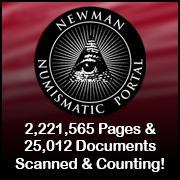
About UsThe Numismatic Bibliomania Society is a non-profit association devoted to the study and enjoyment of numismatic literature. For more information please see our web site at coinbooks.org SubscriptionsThose wishing to become new E-Sylum subscribers (or wishing to Unsubscribe) can go to the following web page link MembershipThere is a membership application available on the web site Membership Application To join, print the application and return it with your check to the address printed on the application. Print/Digital membership is $40 to addresses in the U.S., and $60 elsewhere. A digital-only membership is available for $25. For those without web access, write to: Terry White, Treasurer AsylumFor Asylum mailing address changes and other membership questions, contact Terry at this email address: terrywhite5475@yahoo.com SubmissionsTo submit items for publication in The E-Sylum, write to the Editor at this address: whomren@gmail.com BUY THE BOOK BEFORE THE COINSale Calendar |
- WAYNE'S WORDS: THE E-SYLUM NOVEMBER 14, 2018
- BUY OR BID SALE #8 CLOSES NOVEMBER 14, 2018
- NEW BOOK: SPANISH COLONIAL COINS IN EL SALVADOR
- THE COMMEMORATIVE TRAIL JOINS THE NEWMAN PORTAL
- THE EARLY DAYS OF NUMERICAL COIN GRADING
- MEDAL COLLECTORS OF AMERICA MEETS IN BOSTON
- NOTES FROM E-SYLUM READERS: NOVEMBER 11, 2018
- MORE ON JOHN PINCHES TWO-HEADED MORGAN DOLLARS
- PRESIDENTIAL DOLLAR DOUBLE TAKE: GROVER CLEVELAND
- BLIND MAN'S NICKEL PATTERNS
- VOCABULARY TERMS: MILLED EDGE, MILLED MONEY
- HARRY EDSON KELSO (1902-1988)
- ANS 2018 HUNTINGTON AWARDEE JOHN KLEEBERG
- NEW DELHI NATIONAL MUSEUM NUMISMATICS GALLERY
- THE BANGLADESH BANK CURRENCY MUSEUM
- NUMISMATIC NUGGETS: NOVEMBER 11, 2018
- PRESERVATION TECHNOLOGIES
- WAYBACK MACHINE: THE INTERNET’S TIME CAPSULE
- MEXICO'S LIBERTAD COIN DESIGNS
- AUTHOR ROALD DAHL PASSED OVER FOR COIN DESIGN
- ELECTROTYPE MEDAL SHELLS IN ADVERTISING SIGNS
- MORE HYDRA IMAGES IN NUMISMATICS
- CHRISTIE'S SELLS STEPHEN HAWKING'S MEDALS
- HOW THE CURRIE VICTORIA CROSS STAYED IN CANADA
- PRESIDENT WOODROW WILSON MEDAL PUZZLE ANSWERS
- PANCHO VILLA'S PAPER MONEY
- WHAT IS A "SHORT SNORTER?"
- LOOSE CHANGE: NOVEMBER 11, 2018
Click here to access the complete archive
To comment or submit articles, reply to whomren@gmail.com
Content presented in The E-Sylum is not necessarily researched or independently fact-checked, and views expressed do not necessarily represent those of the Numismatic Bibliomania Society.
WAYNE'S WORDS: THE E-SYLUM NOVEMBER 14, 2018
 This week we open with a numismatic literature
sale reminder, a new book and an update from the Newman Numismatic Portal. Other topics this week include the early days of numerical grading, John Pinches' two-headed Morgan
dollars, the blind man's nickels, numismatic museums, hydra images in numismatics, electrotype medal shells, and short snorters.
This week we open with a numismatic literature
sale reminder, a new book and an update from the Newman Numismatic Portal. Other topics this week include the early days of numerical grading, John Pinches' two-headed Morgan
dollars, the blind man's nickels, numismatic museums, hydra images in numismatics, electrotype medal shells, and short snorters.
To learn more about Spanish Colonial coins circulating in El Salvador, The Commemorative Trail, the IAPN Bulletin on Counterfeits, George Washington's silver Comitia Americana medal set, Grover Cleveland's dollars, milled money, the Wayback Machine, and Stephen Hawking's medals, read on. Have a great week, everyone!
Wayne Homren
Editor, The E-Sylum
BUY OR BID SALE #8 CLOSES NOVEMBER 14, 2018
Here's a reminder that Kolbe & Fanning's Buy or Bid sale closes Wednesday. -Editor
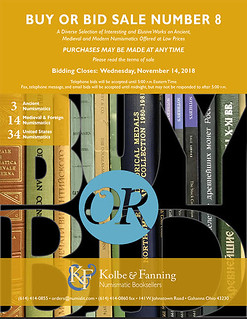 Kolbe & Fanning
Numismatic Booksellers’ eighth “Buy or Bid Sale” will close on Wednesday, November 14. The sale focuses on modestly priced books, giving collectors an opportunity to add to
their libraries at minimal cost.
Kolbe & Fanning
Numismatic Booksellers’ eighth “Buy or Bid Sale” will close on Wednesday, November 14. The sale focuses on modestly priced books, giving collectors an opportunity to add to
their libraries at minimal cost.
The sale includes over 1300 works on ancient, medieval and modern coins, as well as general works, periodicals and sale catalogues. “Buy” prices have been kept low to promote sales. To further encourage participation, the firm is offering free domestic shipping to bidders spending at least $300; there will also be no packing and processing fee for this sale. Again, please read the Terms of Sale before participating.
As the name of the sale suggests, customers may bid on items they wish to acquire or buy them outright at the published price. The Terms of Sale will give full instructions on how to participate: please read it carefully.
There will be no printed catalogue. The PDF catalogue is available now for downloading from the Kolbe & Fanning website at numislit.com .
Please send all bids to orders@numislit.com or use the bid sheet included at the end of the PDF catalogue.
NEW BOOK: SPANISH COLONIAL COINS IN EL SALVADOR
Dale Seppa submitted these notes on a new book by Roberto Jovel. Thank you! -Editor
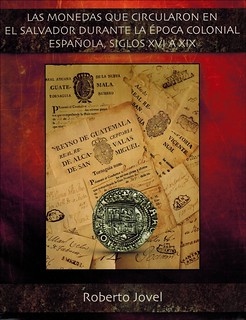 LAS MONEDAS QUE
CIRCULARON EN EL SALVADOR DURANTE LA EPOCA COLONIAL ESPANOLA, SIGOS XVI A XIX (Translation – The Coins that Circulated in EL SALVADOR during the Spanish Colonial Epoch, 16th
to 19th Centuries.) by Roberto Jovel.
LAS MONEDAS QUE
CIRCULARON EN EL SALVADOR DURANTE LA EPOCA COLONIAL ESPANOLA, SIGOS XVI A XIX (Translation – The Coins that Circulated in EL SALVADOR during the Spanish Colonial Epoch, 16th
to 19th Centuries.) by Roberto Jovel.
Newly issued in 2018 this massive (over three pounds) book is in an 8½ by 11 inch format and has 508 well illustrated pages.
I would actually love to do a review on the book but with my aging eyes and rapidly diminishing life span I am afraid that I would never be able to finish it.
While the book is in Spanish the simple fact is that the hundreds of good photos will be of great use to anyone interested in this period of El Salvador’s monetary history.
The book is so new that, as far as I know, it is not currently being offered in the United States. Although several of Jovel’s books are listed on Amazon this one is not included.
NOTE: The book is quite heavy, nearly 4 pounds in weight, which makes it costly to send via regular mail. For ordering information, contact Roberto via email at rjovel@jovel.org -Editor
Roberto adds:
Thanks to Dale for submitting the information about my new book. It is only in Spanish at the present time. It covers the coins that circulated in the country, from the founding of San Salvador in 1525 to Independence from Spain in 1821.
This book, with the additional volumes covering the same subject for the 19th and for the 20th Centuries provides complete coverage of El Salvador´s history of coinage. Please note that El Salvador dollarized its economy in 2001 and no Salvadorian coins/banknotes have been used since then; the country now uses US coins and banknotes only.
THE COMMEMORATIVE TRAIL JOINS THE NEWMAN PORTAL
The latest addition to the Newman Numismatic Portal is The Commemorative Trail. Project Coordinator Len Augsburger provided the following report. -Editor
The Commemorative Trail Joins the Newman Portal Lineup
 Recently added to
the Newman Numismatic Portal is The Commemorative Trail, the journal of the Society for U.S. Commemorative Coins. We are indebted to Alan Meghrig for supplying a set for
scanning. This run covers 1984 to 2011, and, while not exhaustive, appears to be fairly complete. Writers included Q. David Bowers, Anthony Swiatek, Helen Carmody and many
others.
Recently added to
the Newman Numismatic Portal is The Commemorative Trail, the journal of the Society for U.S. Commemorative Coins. We are indebted to Alan Meghrig for supplying a set for
scanning. This run covers 1984 to 2011, and, while not exhaustive, appears to be fairly complete. Writers included Q. David Bowers, Anthony Swiatek, Helen Carmody and many
others.
The journals focus on the modern commemorative series and lend considerable color to the individual issues that one will not find in general sources such as the Guide Book of U.S. Coins. The Winter 1990 issue, for example, discusses plaster casts for the 1932 Washington “commemorative.” Originally conceived as a one-year commemorative coin celebrating the bicentennial of Washington’s birth, the chosen (John Flanagan) concept proved so well-received that a decision was made to replace the current (Standing Liberty) quarter design with Flanagan’s bust.
Link to The Commemorative Trail on NNP:
https://nnp.wustl.edu/library/publisherdetail/529176
I was a subscriber for few years and always enjoyed reading the issues. I've wanted for some time to add a set to the Portal. Thanks to Anthony Swiatek who confirmed that the society is defunct. Alan Meghrig answered my call in The E-Sylum and with no small effort pulled together his set from storage and shipped it to St. Louis for digitization. Thanks to all involved, including students and staff at Washington University in St. Louis. -Editor

THE EARLY DAYS OF NUMERICAL COIN GRADING
On November 5, 2018 CoinWeek published an important article by Tom DeLorey on "The Early Days of Numerical Coin Grading". Here are a couple paragraphs to whet your appetite, but be sure to read the complete article online. -Editor

I decided to add one grade between 60 and 65 and another grade between 65 and 70. For the first one, I chose 63, because I wanted a number that would be closer to 65 than 60, thereby implying a coin that was significantly better than 60 without being good enough for a 65 grade. For the upper number, my choices were 67 or 68, and I chose 67 partly because I thought it had a chance of occasionally being reached (remember, we were not anticipating grading any common modern coins at the time), and partly because 63 and 67 were symmetrical around the highly desired MS-65.
We opened for business on March 1, 1979, using Sheldon’s numbers plus AU-58, which I created for those “un-circulated coins with rub” that I refused to call Mint State, plus MS-63 and MS-67. We also adopted the practice of grading each side separately, so that a Morgan dollar with a few too many bag marks on the cheek but a nice reverse might get an MS-63/65. I guess we were trying to throw a small bone to the people whose coins did not make a full MS-65 by saying “well, half of your coin made it!”
To read the complete article, see:
The Early Days of Numerical Coin Grading
(https://coinweek.com/education/coin-grading/the-early-days-of-numerical-coin-grading/)
MEDAL COLLECTORS OF AMERICA MEETS IN BOSTON
Neil Musante of MCA submitted this report on the just-concluded medal symposium held at the Massachusetts Historical Society. Thanks! -Editor
On Saturday, November 10, the Medals Collectors of America and the Massachusetts Historical Society conducted a day long symposium on the Medal titled “Art and Memory - the Role of Medals.” The 80 or so attendees were treated to an exhibition of some of the great numismatic treasures held in the collection of the Massachusetts Historical Society. After coffee and bagels, a series of lectures were offered by an impressive array of speakers.
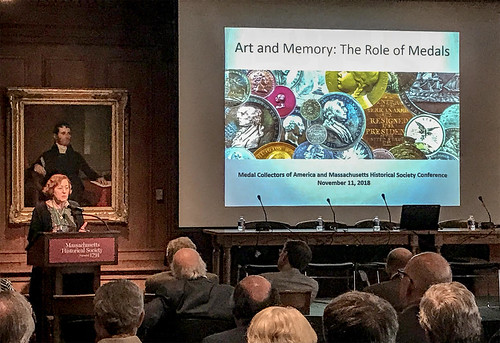
welcomes guests to the conference
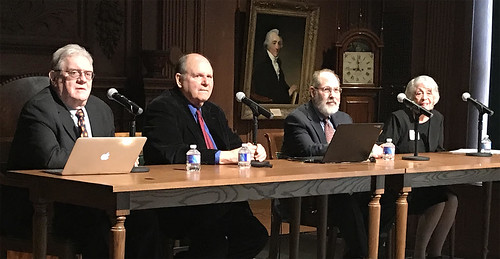
The morning began with a gracious welcome from Anne Bentley, Curator of Art and Artifacts at the MHS. Anne told the wonderful history of the collection from its earliest acquisitions to the present day. This was followed by John Sallay, who reprised his fascinating presentation from the MCA club meeting held at the ANA convention this past August - Their Secrets Revealed! Early American College Secret Society Medals. Alan Stahl, Curator of Numismatics at Princeton University, gave a really interesting talk on the origins and use of medallic symbolism titled Medallic America: Allegorical Representations of America on European and American Medals. A panel consisting of Cory Gilliland, Curator Emerita of the National Numismatic Collection at the Smithsonian Institute, Robert Hoge, Curator Emeritus of the ANS, Scott Miller, author of the book Medallic Art of the American Numismatic Society, 1865-2014, was led in a discussion on “The Art of the Medal,” moderated by ANS Fellow Ira Rezak. This included a lively question and answer followup as participants attempted to define just what constitutes a Medal and what qualifies as “Medallic Art.”
After lunch, attendees were welcomed by new MHS President, Catherine Allgor. Patrick McMahon, Director of Exhibitions at the Boston Museum of Fine Arts delivered a phenomenal paper on The Early Work of Victor David Brenner, followed by an equally great talk on So-Called Dollars as a Reflection of Nineteenth and Early Twentieth Century American Culture, by Jonathan Brecher, co-author of the book So-Called Dollars: An Illustrated Standard Catalog. In the afternoon session, Leonard Augsburger, Project Coordinator for the Newman Numismatic Portal talked on Books and the Medal. Ute Wartenburg Kagan, Executive Director of the American Numismatic Society detailed the fascinating and remarkably successful effort by the ANS to acquire the dies and galvanos of the former Medallic Art Company.
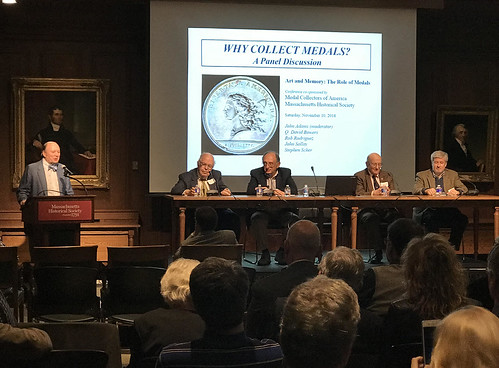
Dave Bowers, Rob Rodriguez, Stephen Scher and John Sallay
The program concluded with a panel discussion on Why Collect Medals. John Adams, numismatic author, researcher and long time editor of The MCA Advisory, brought together the “authors” of some of the greatest collections ever assembled. Stephen Scher, told the story of his earliest acquisition and how that led to the formation of his extraordinary collection of Renaissance portrait medals. John Sallay followed with the tale of his first acquisition, leading to the formation of the most remarkable collection of school medals ever assembled. Rob Rodriguez told us how a bronze Libertas Americana medal inadvertently removed from a box while viewing coin auction lots completely threw him over, and led him to a new and perhaps even more passionate pursuit than coins. To complete the panel, the great Q. David Bowers waxed eloquent on several of his favorite American medals, including the famed 1787 Columbia and Washington medal and the New Haven Bicentennial medal of 1838. Indeed, the audience could have listened to these five gentlemen for the entire evening.
A group of about 60, then adjourned to a private room at the Colonnade Hotel where a really nice dinner was enjoyed by all. The opportunity to meet and talk with fellow collectors and especially with the speakers and panelists was truly a gift, and the organizers of this event are to be thanked and congratulated. The biggest news however, was delivered at the close of the evening by Catherine Allgor, MHS President, who announced the formation of the Anne E. Bentley Fund, established in Anne’s honor for her long and dedicated service to the MHS and its collections, especially their numismatic holdings. Its purpose will be the improvement and expansion of this remarkable numismatic treasure. Anyone interested in learning more or helping with this fund can contact Vice President of Development, Maureen H. Nguyen at mnguyen@masshist.org .
The presentations and panel discussions were all recorded, and will soon be posted to the websites of the MHS (www.masshist.org) and the MCA (www.medalcollectors.org), where information about joining this great organization will also be found.
Len Augsburger participated in this week's MCA conference in Boston and filed this report. Thanks! Photos courtesy Len Augsburger and his wife Debra Kurtz. -Editor
The first conference of the Medal Collectors of America, Art and Memory: The Role of Medals, was held Saturday, November 10 at the Massachusetts Historical Society (MHS) in Boston. Anne Bentley, MHS Curator of Art and Artifacts kicked off the event with a brief overview of the MHS collection, and had selected a number of pieces from the collection that were on exhibit during the conference. These treasures included the gold Manly medal, a Jefferson inaugural medal, and of course the George Washington presentation set of silver Comitia Americana medals.
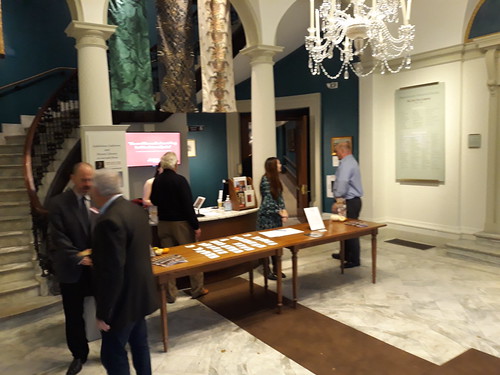
Registration in the MHS Lobby
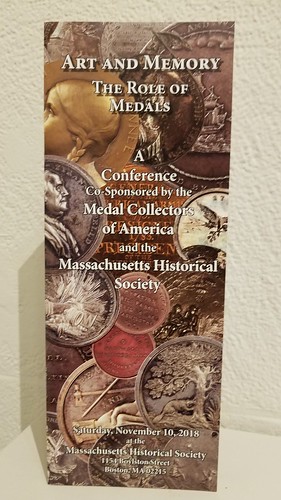
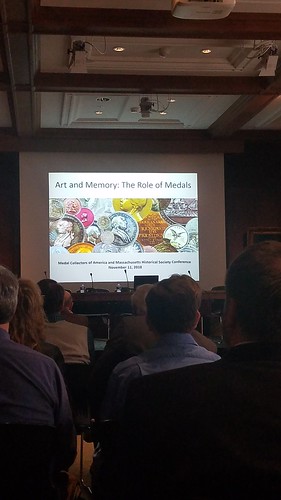
Program Cover and Opening Session
Conference speakers included John Sallay (early American college secret society medals), Alan Stahl (allegorical representations of America on medals), Patrick McMahon (the early work of Victor D. Brenner), Jonathan Brecher (so-called dollars), Len Augsburger (medals and books), and Ute Wartenberg Kagan (Medallic Art Company archives at the ANS). In addition to these presentations, two panel discussions covered “The Art of the Medal” (Ira Rezak, Cory Gilliland, Robert Hoge, and Scott Miller), and “Why Collect Medals?” (John Adams, Q. David Bowers, Rob Rodriguez, Stephen Scher, and John Sallay).
“The Art of the Medal” raised the provocative question “what is a medal?,” and the illustrations of several examples from the recent FIDEM conference led to a lively discussion of a question that is harder to answer than one might first think.
The MHS was a wonderful host to this event, which included brief remarks from Catherine Allgor, MHS president. The MHS building is delightful and inspiring all at once, and one would be hard pressed to imagine a more hospitable venue, which was exceeded only by the quality of the various presentations. The day concluded with a reception at MHS followed by dinner at a nearby restaurant. We are indebted to John Sallay, MCA board member, Anne Bentley of MHS, and to all who helped facilitate this marvelous event.
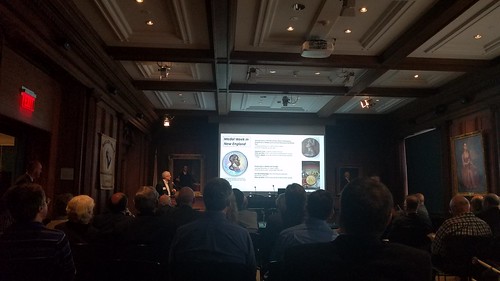
Len Augsburger speaking

Panel discussion
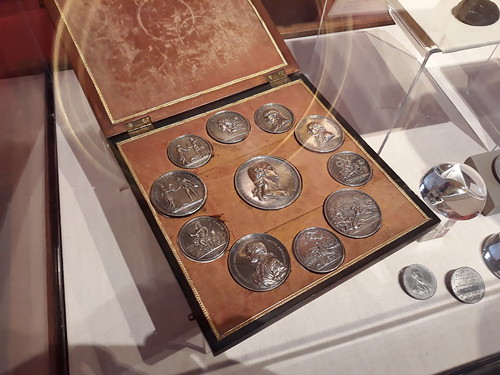
George Washington's silver Comitia Americana medal set
What a great event! I wish I'd been able to attend. Even in the internet age there's no substitute for in-person gatherings such as this. Multipurpose coin shows and conventions are important, but birds-of-a-feather gatherings are memorable, influential, not-to-be-missed events for those with a strong interest in the subject. Military collectors have done this for years with the MPC Fest, and I hope MCA can pull off an encore event someday. It's something every specialty society should consider. -Editor
To read the earlier E-Sylum articles, see:
2018 BOSTON MCA CONFERENCE PLANNED (http://www.coinbooks.org/v21/esylum_v21n01a19.html)
2018 BOSTON MCA CONFERENCE UPDATE (http://www.coinbooks.org/v21/esylum_v21n17a16.html)
2018 BOSTON MCA-MHS MEDALS CONFERENCE REMINDER (http://www.coinbooks.org/v21/esylum_v21n42a19.html)
NOTES FROM E-SYLUM READERS: NOVEMBER 11, 2018
Another Great Issue
Vic Mason writes:
Thanks, Wayne. Each week you send out an amazing compendium of articles. I enjoyed reading about the Australian contest, J.T. Stanton, the Mormon money, and much more here. My Mormon friends out in California might enjoy reading about the latter.
You're welcome. I enjoyed the last issue quite a bit myself. Our readers deserve thanks as well for all their great contributions. Keep 'em coming! -Editor
To read the earlier E-Sylum issue, see:
Volume 21, Number 44, November 4, 2018 (http://www.coinbooks.org/v21/club_nbs_esylum_v21n44.html)
Apollo 16 Bronze Medal Designer Ralph Menconi
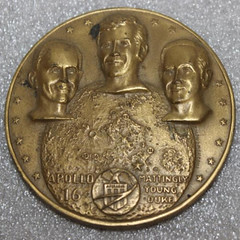
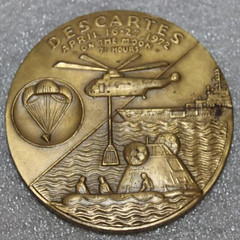
Regarding the above medal, last week I asked, "Would anyone know who the artist is?" -Editor
Yes, I would know. More impressively, I knew even before I found Ralph Menconi’s name along the right edge of the moon.
Dick Hanscom writes:
I am guessing Ralph Menconi. I think he did the Apollo 11 medal.
Scott Miller writes:
The Apollo 16 medal is the work of Ralph J. Menconi. His name appears just to the right of the moon.
Eric Holcomb writes:
The obverse of the Apollo 16 MACO medal is clearly marked RALPH J. MENCONI (see the better photos of a silver medal attached). The reverse was probably done by Menconi too, but I would need to find the original paperwork to be sure.


OK, that was an easy one! Thanks, everyone. I used created a close-up image above of the signature on Eric's silver medal. -Editor
To read the earlier E-Sylum article, see:
Apollo 16 Bronze Medal (http://www.coinbooks.org/v21/esylum_v21n44a24.html)
End of Pity Token?
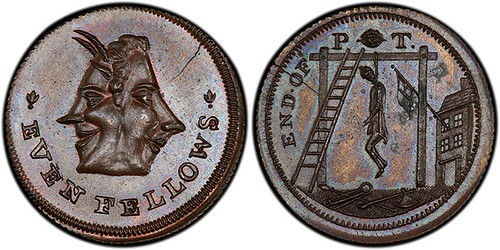
"Reverse: Thomas Paine hanging, above an all-seeing eye looking forward with "End OF" inscribed around to the left of Thomas Paine’s initials "TP". A structure in the distance with the flag of England hanging down."
I note the initials on the actual token read "PT" not "TP", and wonder if this is another pun (like END OF PAIN on another of the tokens illustrated), to be read as "END OF PITY" (phonetically, pee-tee is close enough, I guess). Otherwise, why switch his initials around?
Great observation. Are any of our readers familiar with this piece? What do you think? -Editor
To read the earlier E-Sylum article, see:
EXECUTION SCENES IN NUMISMATICS (http://www.coinbooks.org/v21/esylum_v21n44a33.html)
Harry Mernick's Bois Durci Web Site
Philip Mernick writes:
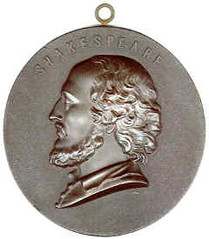 I was interested to see your
mention of a bois durci plaque and your bois durci related links. Readers might also be interested in my brother Harry’s bois durci web site at
I was interested to see your
mention of a bois durci plaque and your bois durci related links. Readers might also be interested in my brother Harry’s bois durci web site at
http://www.mernick.org.uk/BDWeb/
It shows a wide range of articles made of this versatile material including for those more numismatically inclined a comprehensive listing of the medallic portrait plaques. These include three Americans, George Washington, Abraham Lincoln and William H. Seward.
Thanks! Nice site. -Editor
To read the earlier E-Sylum article, see:
NUMISMATIC NUGGETS: OCTOBER 28, 2018 : Bois Durci Medallion
(http://www.coinbooks.org/v21/esylum_v21n43a15.html)
Hall of Fame for Great Americans Medals Manuscript
David Thomason Alexander writes:
Heartiest congratulations to Mel Wacks on his recently announced catalog of medals of the Jewish-American Hall of Fame. I myself have worked for several years of the long-defunct medal series of the Hall of Fame for Great Americans at New York University (HOF). The owner of this great sculptural memorial is now Bronx Community College. The HOF series burst on the scene in 1962-63 amid vast publicity, struggling on until 1974. The series includes some of the finest work of the greatest American medalists but proved a commercial disaster and is almost totally forgotten in 2018.
There exists a finished manuscript on the HOF medals with a complete digital photographic record of the silver medals that awaits a publisher. I proposed publication to the American Numismatic Society a few years ago, even offering a combined study with the Jewish-American Hall of Fame but found minimal interest, though the Society did a splendid job with my "American Art Medals, 1909-1995, Circle of Friends of the Medallion and Society of Medalists," published in 2011, and with Scott Miller's more recent study of "Medallic Art of the ANS."
Possibly some E-Sylum reader might have thoughts about publication ?!?
To read the earlier E-Sylum article, see:
NEW BOOK: JEWISH-AMERICAN HALL OF FAME MEDALS (http://www.coinbooks.org/v21/esylum_v21n43a03.html)
IAPN Bulletin on Counterfeits Sought
Regarding a publication of the International Association of Professional Numismatists, Hadrien Rambach writes:
Several sets of the IAPN’s Bulletin on Counterfeits have been sold in the past few years, but it seems that none were complete, so it seems worth doing a list of what a complete set would contain, and I have listed those that I have.
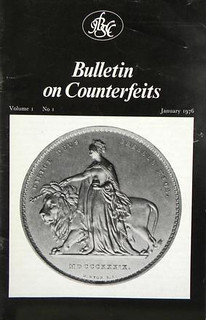 Vol. 1 (1976) nos 1-2-3-4
Vol. 1 (1976) nos 1-2-3-4
Vol. 2 (1977) nos 1-2-3-4
Vol. 3 (1978) nos 1-2-3-4
Vol. 4 (1979) nos 1-2/3-4
Vol. 5 (1980) no. 1/2
Vol. 6 (1981) no. 1/2
Vol. 7 (1982) no. 1/2
Vol. 8 (1983) no. 1/2
Vol. 9 (1984) no. 1
Vol. 10 (1985) nos 1-2
Vol. 11 (1986) nos 1-2
Vol. 12 (1987) nos 1-2
Vol. 13 (1988) nos 1-2
Vol. 14 (1989) nos 1-2
Vol. 15 (1990) no. 1
Vol. 16 (1991) no. 1
Vol. 17 (1992) nos 1-2
Vol. 18 (1993) nos 1-2
Vol. 19 (1994) nos 1-2
Vol. 20 (1995) nos 1-2
Vol. 21 (1996) nos 1-2
Vol. 22 (1997) no. 2
Please let me know of any issue that I am missing (and I would be grateful if you could help me find copies).
Can anyone help? Image courtesy Kolbe & Fanning Numismatic Booksellers, who also provided some missing entries for the list. -Editor
David Fanning adds these:
Vol. XXII, No. 1
Vol. XXIII, Nos. 1-2 (combined issue)
Vol. XXIV, No. 1.
Those are the only missing issues. I’ve sold a couple complete runs.
To read the complete lot description, see:
Bulletin on Counterfeits
(https://bid.numislit.com/lots/view/1-8Z9K9/bulletin-on-counterfeits)
National Coin Hobby Act Enforcement
Last week Yosef Sa'ar asked about enforcement of the National Coin Hobby Act. Christopher R. McDowell, Editor of The Journal of Early American Numismatics, writes:
The August 2016 edition of The Colonial Newsletter presented an article on the subject: Danielle List, “The Hobby Protection Act’s Safeguards for Colonial Coinage,” CNL, Vol. 56, Serial 161, August 2016, p. 4405. The article examined the law and enforcement of the law over the years. The act itself can be found at 15 U.S.C. Chap. 49, § 2101, et seq.
The American Numismatic Society may still have a copy of this back issue that can be purchased. Anyone who is a current subscriber to JEAN can contact me and I will provide electronic copies of articles not yet on the Newman Portal. I have discussed with ANS the possibility of putting all the old CNL issues on the Portal, but I don’t think that has happened yet. I believe the current agreement is a 3 year delay.
Thanks. -Editor
To read the earlier E-Sylum article, see:
NOTES FROM E-SYLUM READERS: NOVEMBER 4, 2018 : National Coin Hobby Act Enforcement
(http://www.coinbooks.org/v21/esylum_v21n44a11.html)
More on Grover Criswell
Jeffrey S Zarit writes:
I cannot say that I knew Grover Criswell very well, however, I do remember the first time I met him, at a coin show in Indianapolis, where I split a case of champagne with him and John Pittman, and George Hatie.
I have had many colleagues from the 1970's relate their stories about Grover. To say that he was a character, is putting it very mildly.
Those were the days of cocktail parties in hotel rooms at coin shows. At one of them, I got cornered by John Pittman and had to give him a check for Life Membership on the spot ($200) before he would let me leave. And those were quiet times, ask my colleagues who handle US coins about antics back then!!!
To read the earlier E-Sylum article, see:
NOTES FROM E-SYLUM READERS: NOVEMBER 4, 2018 : Grover Criwsell's Two Dollar Bills
(http://www.coinbooks.org/v21/esylum_v21n44a11.html)
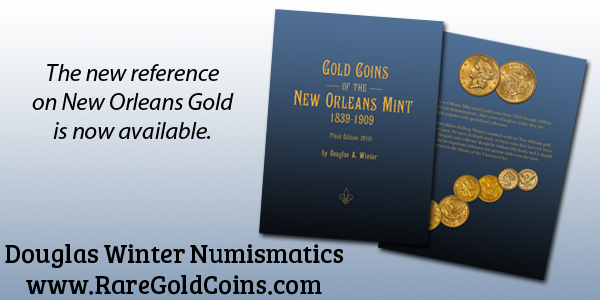
MORE ON JOHN PINCHES TWO-HEADED MORGAN DOLLARS
Regarding the 1879 pattern Morgan dollars produced by John Pinches Ltd., Saul Teichman forwarded this information from the uspatterns.com web site. Thanks! -Editor
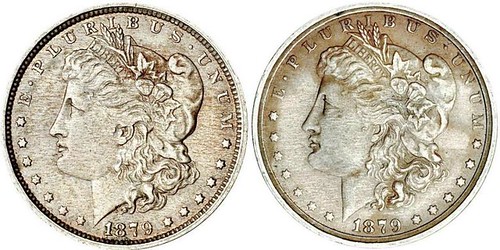
These two-headed Morgan dollars were made by the John Pinches Company in 1900 to show how dies could be reversed engineered from coins according to an article in the 11/18/87 edition of Coin World.
These were struck in the following combinations with pedigree updates from SpinkSmythe's 5/11 Magnolia sale:
Silver P5125 ex Pinches (Glendining 7/47, Glendining 11/87, Eric Green, Private sale at the 1988 New York International Numismatic Convention, ANR 7/05 in cased set with 2 dies and one of the copper nickel pieces as imaged below.
Copper-nickel P5130 with 2 known as follows
1) ex Pinches-Glendining 7/47, Bowers and Ruddy 11/74, Bowers and Merena 1/84.
2) ex Pinches-Glendining 7/47, Private sale in London in 1972, ANR 7/05 in set with the silver piece.
Copper P5135 with 2 known as follows:
1) ex Pinches-Glendining 7/47, Bowers and Ruddy 2/74, Magnolia-SpinkSmythe 5/11
2) ex Pinches-Glendining 7/47, Bowers and Merena 11/74, Bowers and Ruddy 6/80, Auction 88.
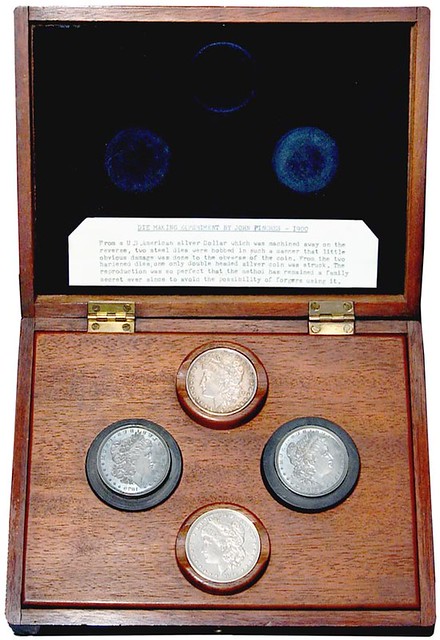
Photo courtesy of American Numismatic Rarities.
Saul Teichman adds:
To my knowledge, the lot containing the dies and all of the coins except one are in a single collection today.
To read the complete article, see:
P5130 (http://uspatterns.stores.yahoo.net/p5135.html)
To read the earlier E-Shylum article, see:
JOHN PINCHES TWO-HEADED MORGAN DOLLARS (http://www.coinbooks.org/v21/esylum_v21n44a20.html)
PRESIDENTIAL DOLLAR DOUBLE TAKE: GROVER CLEVELAND
Here's a two-headed dollar of another sort. -Editor
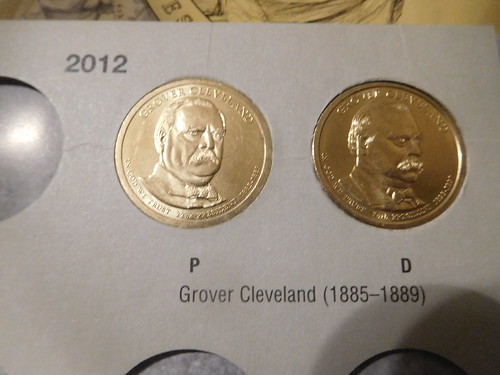
Web site visitor Larry Bennett writes:
I am a collector who fills slots in books and I do not collect the various errors so I do not follow all the news about them. However, when I was looking at my collection of Presidential dollars, I noticed something interesting about the Grover Cleveland coins. The P and D coins have different images. It looks like the P coin has the image of Theodore Roosevelt instead of Grover Cleveland.
Thanks for your note. This is an interesting topic. Cleveland was the only President to serve nonconsecutive terms. He has a coin for each term. Take a closer look at the dates.
Grover Cleveland (1st term)(1885-1889)
Benjamin Harrison (1889-1893)
Grover Cleveland (2nd term)(1893-1897)
Below are images of the two coins from the U.S. Mint web site. -Editor
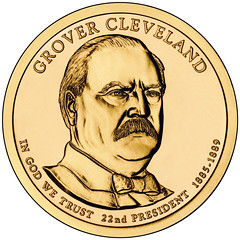
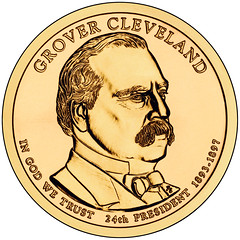
1st and 2nd term Grover Cleveland obverses
Larry adds:
I returned to my coin book and found the second set of slots for his second term. I had forgotten (if I had ever been taught) that he served 2 non-consecutive terms. I need a magnifying glass to read the print under the image but I can now see that they are different. So, in summary, thanks very much for the explanation.
I still think the first image looks like Teddy R! It must be the mustache!
I can see the resemblance! This is an easy mistake to make - I'll bet there are plenty of Presidential Dollar albums filled incorrectly. Thanks for the opportunity to discuss this historical anomaly. -Editor
Here's some more information:
https://www.usmint.gov/learn/coin-medal-programs/presidential-dollar-coin
BLIND MAN'S NICKEL PATTERNS
Rich Giedroyc's Coin Clinic column in the November 20, 2018 Numismatic News mentions the "blind man's nickel" patterns. Here's some more information from an article on the NGC message boards. -Editor
Most of us remember the 2006 ruling by U.S. District Judge James Robertson in a lawsuit filed by the American Council of the Blind that claims the U.S. Department of Treasury is violating the Rehabilitation Act of 1973 with its paper money, right?
Well, way back in 1882 the United State Mint was considering a special pattern nickel, now known as the “Blind Man’s Nickel.” Under the auspices of William Barber, one of the mint’s designers, George T. Morgan produced a handful of some proof Liberty nickels and Shield nickels with an edge that had five raised bars spaced at regular intervals so that the blind could determine by the touch, its denomination. These coins were never released for circulation but the few that were struck did indeed find their way into collectors hands.
The "Blind Man's Nickel" has long been a favorite of pattern collectors, both due to its extreme rarity and its highly unusual edge device. Two such Nickel designs were struck; one being the Shield Nickel design, the other, also struck bearing the date 1882 is of a Liberty Head design, similar to the adopted design but bearing the obverse legend UNITED STATES OF AMERICA rather than stars. According to John Haseltine in his sale of March 1, 1883, these Nickels were "designed for the use of the blind" and that these "bold ridges" were placed "on the edge so that the blind could determine by the touch its denomination." Apparently, the need for such a coin was deemed to not be sufficient, nor was the idea practical to carry over into other denominations, not to mention that the raised bars along the edge also posed potential jamming problem for the coin presses.

1882 5C Liberty Head Five Cents, Judd-1683, Pollock-1883, High R.7, PR64 PCGS
J1683/P1883 Copper-nickel Only 3 were struck according to the addenda in Haseltine's March 1883 sale. At least 3 are in fact known today.
Only 3 are confirmed including the Mitchelson-Connecticut State Library and Harry W. Bass Jr. Research Foundation pieces and the illustrated example which is from Bowers and Merena's October 2000 sale. The latter is probably the Judd coin as well.
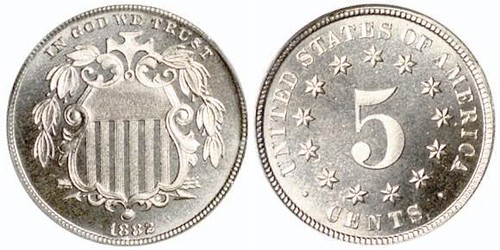
1882 five cents. "Blind man's" nickel. Nickel. Judd-1697, Pollock-1899. Rarity-7
To read the complete article, see:
1882 Blind Man’s Nickel
(https://www.ngccoin.com/boards/topic/145547-1882-blind-man%E2%80%99s-nickel/)
E-Sylum supporter Julian Leidman has one for sale in his eBay store. -Editor
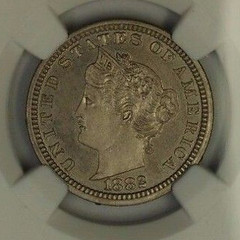
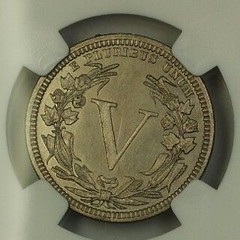
1882 Liberty V Nickel Pattern Proof 5c Coin
NGC PF-64 Judd 1683
Nicknamed the "blind man's nickel", the edge of this coin has five equally spaced bars to distinguish it's denomination.
To read the complete lot description, see:
1882 *Blind Man's* Liberty V
Nickel Pattern Proof 5c NGC PF-64 J-1683 Judd WW
(https://www.ebay.com/itm/1882-Blind-Mans-Liberty-V-Nickel-Pattern-Proof-5c-NGC-PF-64-J-1683-Judd-WW-/192110588292?hash=item2cbaaef184)
The NGC article concludes, "I could not find one single image of the edge, go figure." Me neither. Can anyone point us to images of the coins' edges? Thanks. Meanwhile, I reached out to reader Tom Babinszki, author of the Blind Coin Collector blog. -Editor
Tom writes:
I’ve been researching this topic, but I have never heard about these U.S. patterns. Though I have to say, I didn’t even assume that money identification existed for the blind over a hundred years ago.
Unfortunately the one on eBay is outside of my spending range, though I would be happier with one without a holder.
Julian Leidman said he'd bring his piece to our Nummis Nova dinner on Tuesday. I'll tease him about breaking the Proof-64 pattern out of its slab before passing it around the table. -Editor

VOCABULARY TERMS: MILLED EDGE, MILLED MONEY
Dick Johnson submitted this entry from his Encyclopedia of Coin and Medal Terminology. Thanks. -Editor
Milled Edge. A smooth, raised edge, one treated by upsetting. A milled edge is required for COINING. Adjusted blanks are pre-formed into planchets by passing through an UPSETTING machine. This makes the blanks perfectly round, all burrs are removed from the edge, the edge is completely smooth and a slight rim is created. Such deburring and milling prevents jams in the coining press, insuring a smoother feeding and coining. The milling process is not to be confused with REEDING or KNURLING on the edge, as this is performed by the COLLAR during coining. See EDGE, UPSETTING.
Reference:
NE42 {1982} Doty, p 211.
In response to an offline reader question about milled coinage, here's a similar-sounding but unrelated definition from the Newman Numismatic Portal Numismatic Dictionary. This one relates to a method of manufacture rather than a feature of the finished product. -Editor
Milled Money A name given to such coins as were made by the employment of the mill and screw process which superseded the hammered coins (q.v.).
Folkes states that "the maker of this milled money is reported to have been one Philip Mastrelle, a Frenchman, who eventually, however, fell into the practice of coining counterfeit money, and was convicted, and executed at Tyburn, on the 27th of January, 1569." Kenyon states that the "new process of coining, by means of the mill and screw, was introduced into England from France, apparently by a Frenchman called Eloye Mestrell." Hawkins, on the other hand, asserts that "the name of the Frenchman is unknown and the whole history of the process and its employment is involved in singular obscurity."
One thing, however, is certain, and that is that from 1561 to 1575 milled coins were made in England, but as they did not win entire approval, they were discontinued and not revived until November 5, 1662, when a warrant was issued for coining by the mill altogether.
Shakespeare alludes to the milled Sixpence in The Merry Wives of Windsor (i. 1).
For an exhaustive treatise on the early minting operations by mill and screw, see Mr. W.J. Hocking's monograph entitled Simon's Dies in the Royal Mint Museum, with Some Notes on the Early History of Coinage by Machinery, contributed to the Numismatic Chronicle (4th Series, vol. ix).
Source: Frey's Dictionary (American Journal of Numismatics, Vol. 50, 1916)
Looking for the meaning of a numismatic word, or the description of a term? Try the Newman Numismatic Portal's Numismatic Dictionary at: https://nnp.wustl.edu/library/dictionary
Or if you would like a printed copy of the complete Encyclopedia, it is available. There are 1,854 terms, on 678 pages, in The Encyclopedia of Coin and Medal Technology. Even running two a week would require more than 19 years to publish them all. If you would like an advance draft of this vital reference work it may be obtained from the author for your check of $50 sent postpaid. Dick Johnson, 139 Thompson Drive, Torrington, CT 06790.
HARRY EDSON KELSO (1902-1988)
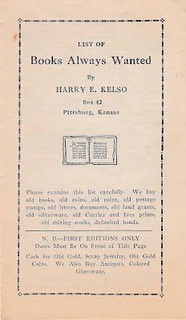 Harry Edson Kelso (1902-1988), was
born in Grant City, Montgomery County, Iowa on July 23, 1902, son of Leon Edson Kelso (1875-1933), and Ella Jane Piper Kelso (1870-1945).
Harry Edson Kelso (1902-1988), was
born in Grant City, Montgomery County, Iowa on July 23, 1902, son of Leon Edson Kelso (1875-1933), and Ella Jane Piper Kelso (1870-1945).
Harry E. Kelso never graduated high school finishing his junior year. He left school and took up the trade of a shoemaker when he lived at Arma, Kansas. He never married and lived with his parents working as a shoemaker in his own shoe repair shop at Pittsburg, Kansas. He conducted an antique business as a sideline buying old U. S. and foreign coins, paper money, postage stamps, old books, antique glass and jewelry, etc.
He died on May 21, 1988, at Miami, Oklahoma. He is buried in Highland Park Cemetery, Pittsburg, Crawford County, Kansas.

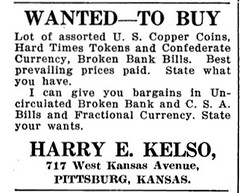
Kelso's ads in The Numismatist 12/1919 and 12/1922
To read the complete article, see:
KELSO, HARRY EDSON, Jr.
(https://sites.google.com/a/numismaticmall.com/www/numismaticmall-com/kelso-harry-e)
The entire inventory of the Lupia Numismatic Library is for sale. Individual items will be available before the remaining archives are broken up into parcels sold at philatelic auctions in the U. S. and Hong Kong. Check NumismaticMall.com frequently as dozens of new items with estimates will be posted daily until everything is sold.
All inquiries will be given prompt and courteous attention. Write to: john@numismaticmall.com .
ANS 2018 HUNTINGTON AWARDEE JOHN KLEEBERG
Congratulations to John Kleeberg, winner of this year's ANS Huntington Award. here's the press release. -Editor
The American Numismatic Society Awards its 2018 Archer M. Huntington Award for Excellence in Numismatic Scholarship to Dr. John M. Kleeberg.
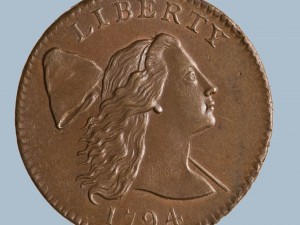 The Trustees of the American Numismatic Society
(ANS) have voted to bestow upon Dr. John M. Kleeberg the 2018 Archer M. Huntington Award in recognition of his scholarly work on modern numismatics. The award ceremony will be
held on Tuesday, December 4, 2018, at 6:00 p.m. at the American Numismatic Society, 75 Varick Street, floor 11, in New York City. Featured during the event will be the Silvia Mani
Hurter Memorial Lecture by Dr. Kleeberg, entitled “Dr. William H. Sheldon, Ted Naftzger and the Large Cent Thefts.” The lecture will be preceded by a reception in Dr.
Kleeberg’s honor at 5:30 p.m.
The Trustees of the American Numismatic Society
(ANS) have voted to bestow upon Dr. John M. Kleeberg the 2018 Archer M. Huntington Award in recognition of his scholarly work on modern numismatics. The award ceremony will be
held on Tuesday, December 4, 2018, at 6:00 p.m. at the American Numismatic Society, 75 Varick Street, floor 11, in New York City. Featured during the event will be the Silvia Mani
Hurter Memorial Lecture by Dr. Kleeberg, entitled “Dr. William H. Sheldon, Ted Naftzger and the Large Cent Thefts.” The lecture will be preceded by a reception in Dr.
Kleeberg’s honor at 5:30 p.m.
Dr. Kleeberg has longstanding ties to the ANS, having been elected a Fellow of the Society in 2003 and serving as the Society’s Curator of Modern Coins and Currency from 1990 to 2000. He arrived with an already distinguished academic background: he graduated from Yale University with a double major in History and Classics and received a D.Phil. in Modern History from Oxford University with his dissertation “The Disconto-Gesellschaft and German Industrialization: A Critical Examination of the Career of a German Universal Bank, 1851–1914.” In 2003 he received a law degree from New York University School of Law, after which he was employed as the Senior Restitution Claims Associate, Swiss Deposited Assets Program (2004–2010). Currently, Dr. Kleeberg is Historical Analyst for the Conference on Jewish Material Claims Against Germany, Inc.
Dr. Kleeberg’s impressive publication record includes two books, both of which reflect the thoroughness with which he has approached all his scholarly research. They are: Numismatic Finds of the Americas: An Inventory of American Coin Hoards, Shipwrecks, Single Finds, and Finds in Excavations. Numismatic Notes and Monographs 169; and (with David T. Alexander) An Island of Civility: The Centennial History of the New York Numismatic Club 1908/09-2008/09. He has also delivered many papers, edited books on a wide range of subjects, written numerous book reviews and literature surveys, and critically, contributed some 76 articles, many of which can be grouped under the broad headings of: Coin Hoards/Treasure Trove and Shipwrecks; Counterfeiting and Forgeries; Countermarks/Counterstamps and Minting Technology; and Numismatics and the Law. They also include 16 studies on modern Irish, Dutch, German, British, and international coinage, 12 articles on New York numismatic history, and 12 biographical sketches. Among the latter are “Frank Campbell and the ANS Library: An Appreciation,” in The Colonial Newsletter; and, in American National Biography, both “John Sanford Saltus,” the prominent supporter of the arts for whom the ANS Saltus Award is named, and a look at George Hubbard Clapp, donor of the ANS’s large cent collection.
“John Kleeberg is a numismatic scholar par excellence,” says ANS Executive Director Dr. Ute Wartenberg. “The committee was particularly impressed by Dr. Kleeberg’s scholarship in a great variety of subjects, which made him an obvious choice for this prestigious award. A true contrarian, he often challenges longstanding interpretations in his research, but he is also dedicated to setting American and modern coins in their historical context. “
Reservations are requested for the lecture at 6:00 p.m. and the preceding reception at 5:30. Please contact membership@numismatics.org, or 212-571-4470. ext. 117. Government issued photo I.D. required for entry.
A subscription dinner will be held following the event at a nearby restaurant. Pre-registration is required. Contact membership@numismatics.org for details.
The Archer M. Huntington Award, first presented to Edward T. Newell in 1918, is conferred annually in honor of the late Archer M. Huntington, ANS President from 1905 to 1910, in recognition of outstanding career contributions to numismatic scholarship. The medal was designed in 1908 by Emil Fuchs to commemorate the 50th anniversary of the founding of the American Numismatic Society.
To read the complete article, see:
2018 Huntington Award to John Kleeberg (http://numismatics.org/2018-huntington/)
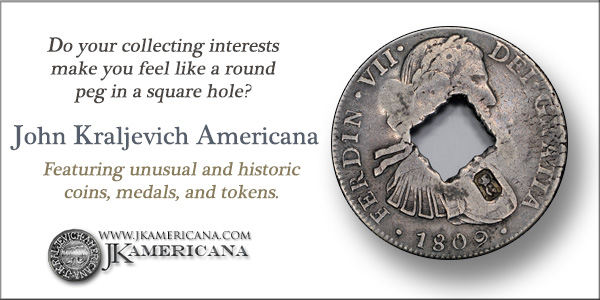
NEW DELHI NATIONAL MUSEUM NUMISMATICS GALLERY
We love numismatic museums at The E-Sylum. The November 6, 2018 issue of News & Notes from the Society of Paper Money Collectors included a link to an article about the numismatics gallery at New Delhi’s National Museum. here's an excerpt. Thanks. -Editor

A tableau shows workers engaged in coin-casting process
“II am visiting this gallery for the second time in a month,” says Ayushi, a New Delhi-based history honours student. “The glimpse into the past is so fascinating that I have brought along my friends to have a first-hand experience of the remarkable collection of Indian currency,” she adds. The coins gallery on the first floor of the National Museum at Janpath is certainly remarkable for its variety, rarity and antiquity. It provides a trip back in time to a world when coins were the sole currency. Sanjib Kumar Singh, archaeologist and museologist, National Museum, remarked, “It traces the journey of Indian coinage from its shell avatars to the modern-day plastic version of credit cards. Aptly called, ‘From Cowries to Credit Cards’, it has on display more than 1,500 most famous coins from the museum’s vast collection.” “The entire history of Indian coinage, starting from about 6th century BCE to the beginning of the 21st century CE, is well represented along with the dioramas depicting various techniques of coin production. It has been set-up in such a manner that not only historians and researchers but even the general public find it interesting,” Singh, also spokesperson for the museum, added.
Bringing alive the money trade in all its hard forms, several sections depict, through clay models, how different forms of coins were moulded, punched, cast and marked.
Interspersed with coins on display are historical facts that provide an insight into these coins. A panel reads, “Between 6th century BCE and 1st century CE, merchant guilds and royal families used punch-marked silver and copper coins all over India. The process of making the metal sheets, cutting them into strips and then to pieces of uniform sizes and weight varied from one period to another.” Barring minor variations, it remained the same during the Imperial period. These coins bear various symbols including: bulls, elephants, rabbits, deer, turtles, palm tree, fig tree, wheels and the sun. For a punch-marked coin, a blank coin and one or more punches are required. Pande explains, “The punch is a narrow cylindrical metallic bar bearing the outline of a symbol. Impressing upon a pre-processed and highly heated blank coin produces the punch-marked coin.”
A series of inscribed and non-inscribed copper coins were also used in several north-Indian states. While the early coins bore symbols from tribal and popular cults, they paved the way for Buddhist and Brahmanical religious symbols.
While talking to the curators, I spy a young student taking pictures of a particular section with his smartphone. “I will show these to my teacher,” he says. On display are Babur’s coins inscribed with his name and title. His son, Humayun followed the tradition. Akbar issued coins in gold, silver and copper. His coins were round and square in shape. The commemorative gold coins during his reign were hexagonal. “The Mughal coinages have been ranked among the greatest currencies in the world for their originality and innovative hallmarks,” the curator says.
To read the complete article, see:
A museum tracing the journey of Indian coinage
(https://gulfnews.com/culture/heritage/a-museum-tracing-the-journey-of-indian-coinage-1.2296121)
THE BANGLADESH BANK CURRENCY MUSEUM
The November 6, 2018 issue of News & Notes also included a link to some photos of Taka Museum (Currency Museum) in Dhaka, Bangladesh. Thanks. -Editor
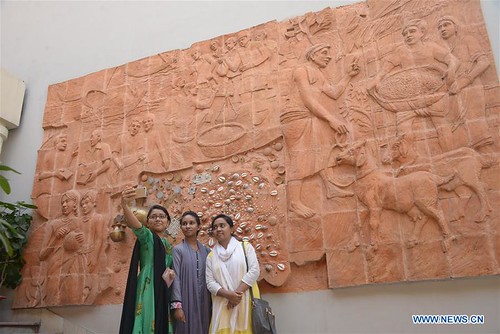
Visitors take selfie at a currency museum in Dhaka, Bangladesh, on Nov. 5, 2018. The museum was established by the central bank of Bangladesh to display coins and currencies all over the world.
To read the complete article, see:
Currency museum established by central bank of Bangladesh displays coins and currencies in Dhaka
(http://www.xinhuanet.com/english/2018-11/06/c_137584918_2.htm)
A nice article on the museum with more images was published in September. Here's an excerpt. -Editor
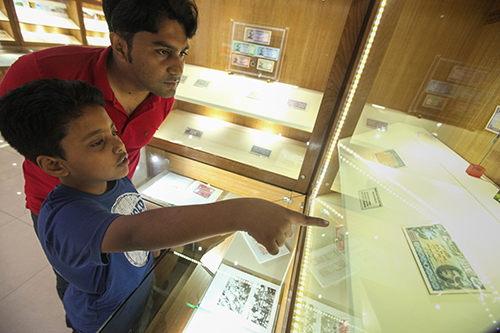
At the museum, coins and currencies are currently exhibited in two galleries. The first contains 43 display cases with approximately 1100 objects. The story of the evolution of coins and currencies starts right here.
The gallery shows its visitors how people traded goods long before the tradition of coins and bank notes prevailed.
The ancient silver punch marked coins of the fourth to second century BC (Before Christ)speak of the earliest history of coins in Indian subcontinent.
The collection also includes Kushan coins from 30 to 375 AD (Anno Domini), Indo Greek Silver coins from 2nd to 1st century AD, Cowry shells, Harikel Coin from 7th to 9th century AD.
Next to the huge collection of Harikel coins brought from the ancient archaeological site, Mainamati, coins from the time of Delhi and Bengal Sultans and Mughal Emperors are showcased in detail in different sections.
Gold coins of Chandragupta are also one of the main attractions of the gallery, while another attraction is the collection of rare bank notes of China, Russia and Germany, Achia Khanom, the keeper of the museum said.
From the symbols of British India from 1947 to the Pakistani coins and bank notes till 1971 are also showcased at the gallery.
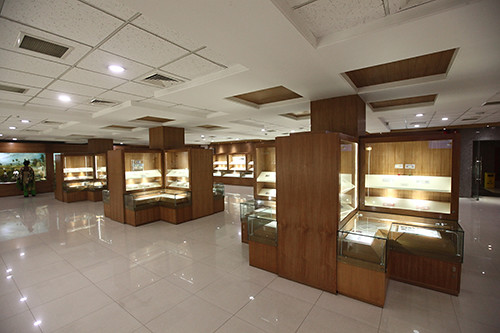
Besides different currencies, the gallery also exhibits different pouches and pots which were used to preserve coins in ancient times as well as different dices, which were used to make coins.
The second gallery showcases coins and currencies of about 120 countries including India, China, Cambodia, Mauritius, Kazakhstan, Syria, Bahrain, Oman, the Philippines, Sri Lanka, Qatar, United Arab Emirates, Kuwait, Australia and many more.
To read the complete article, see:
Coins and currencies: Taka Museum makes history
travel easier (https://www.dhakatribune.com/bangladesh/dhaka/2018/09/24/coins-and-currencies-taka-museum-makes-history-travel-easier)
And here's some text from the bank's home page for the museum. -Editor
Welcome you all to visit Taka Museum. It is the only specialized museum on numismatics in Bangladesh. Its main objective is to show the glorious history of coins and currency of Bangladesh from ancient to modern period along with the different currencies of other countries of the World.
Aspects: The main aspects of Taka Museum are to collect, preserve, display and research the monitory tradition of Bangladesh. Taka Museum also discovers the untold history of the currencies through various kinds of research and publications. Here coins and notes with relevant objectshave been displayed attractively with detail information. Another important aspect of the museum is to foster the history of money to the common people by the displayed objects and provide the visitors immense pleasure.
History: Taka Museum was established first as a Currency Museum in 2009 at the 3rd floor of the main building of Bangladesh Bank at Motijheel. But that was not open to all. Considering the importance and necessity Dr. Atiur Rahman, honorable governor of Bangladesh Bank took the initiative to establish a full fledge currency museum in 2012 equipped with modern digital facilities, technology, architecture & art so that the glorioushistory and traditions of our currency can be preserved in a befitting manner. Later on this currency museum was named as Taka Museum.
Taka Museum started its journey on 27 April, 2013 with the foundation stone laid by Sheikh Hasina, honorable Prime Minister of the Government of the People's Republic of Bangladesh. The museum was inaugurated formally on 5 October, 2013 by Dr. Shirin Sharmin Chowdhury, honorable Speaker of the national assembly. From then the museum is declared open to all.
Activities: Taka Museum collects, preserves and conserves, displays and ensures the Security and documentation of the objects. It also arranges seminar, symposium and do research works related to the history of coins. Taka Museum has few publications also.
To read the complete article, see:
Welcome you all to visit Taka Museum (https://www.bb.org.bd/museum/index.php)

NUMISMATIC NUGGETS: NOVEMBER 11, 2018
Here's a selection of interesting or unusual items I came across in the marketplace this week. Tell us what you think of some of these. -Editor
Achaemenid Kingdom: King in Action
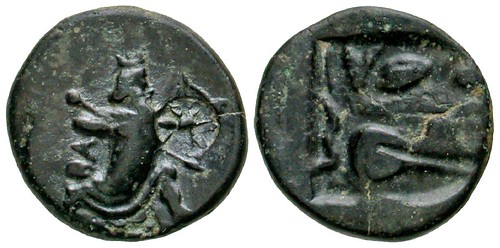
Lot 044. Achaemenid Kingdom. Uncertain satrap. ca. 350-333 B.C. AE 15.
Achaemenid Kingdom. Uncertain satrap. ca. 350-333 B.C. AE 15 (14.9 mm, 1.98 g, 7 h). King in kneeling/running stance right carrying transverse spear and bow; to right, c/m of 8-pointed sun / Incuse relief map of the hinterland of Ephesos. Cf. Mildenberg, Münzwesen pp. 25-26 & plate XIII, 112; BMC 7. VF for type, smooth black patina.
The King as an action hero! I like it. From Agora Auctions Sale #79, closing Novmber 20, 2018. -Editor
To read the complete lot description, see:
Lot 044. Achaemenid Kingdom. Uncertain satrap. ca. 350-333 B.C. AE 15.
(https://www.agoraauctions.com/listing/viewdetail/41635)
Medal Commemorating the Introduction of the Pine Apple in the Netherlands
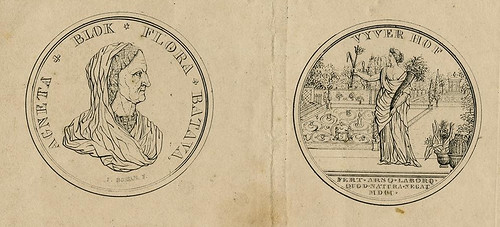
Antique print, titled: 'Agneta Blok [.]' - Two sides of a medal commemmorating the introduction of the pine apple in the Netherlands by Agneta Blok. Curious 19th. Engraving after the medal by Jan Boskan. Source unknown, to be determined. Engraving on wove paper. Anonymous. Good, given age. Ample margins, old central fold. Some foxing. Two small tears in right margin, consolidated with archival tape. General age-related toning and/or occasional minor defects from handling. Please study scan carefully. The overall size is ca. 25.2 x 15.8 cm. The image size is ca. 15.2 x 9 cm. The overall size is ca. 9.9 x 6.2 inch. The image size is ca. 6 x 3.5 inch
Unusual topic. I'm not familiar with this medal. Is the print just a plate removed from a numismatic book? Maybe our E-Sylum sleuths can track it down. I've cropped it to just the medal image itself; the rest of the page in blank. See the lot description for the complete image. -Editor
To read the complete lot description, see:
Antique Print-BIOLOGY-PINE APPLE-MEDAL-AGNETA BLOK-Anonymous-1820
(https://www.abebooks.com/servlet/BookDetailsPL?bi=30130271252)
1891 Bank of Montreal $10 Proof Specimen
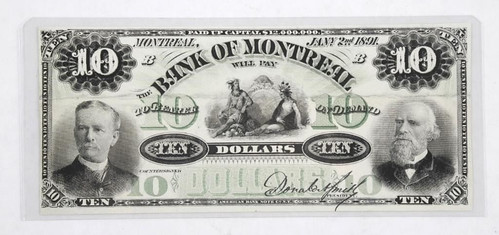
Bank of Montreal 1891 2 Sided Proof Specimen Very Scarce
To read the complete lot description, see:
Bank of Montreal 1891 2 Sided Proof Specimen
(https://auction.auctionnetwork.ca/Bank-of-Montreal-1891-2-Sided-Proof-Specimen-Very_i31858544)
$10 Sacramento, CA National Bank Note
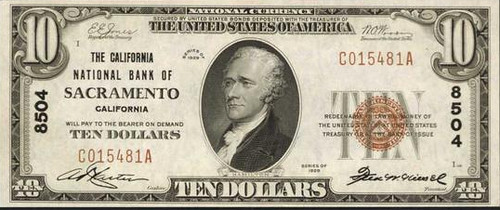
Sacramento, California. $10 1929 Ty. 1. Fr. 1801-1. The California NB. Charter #8504. PCGS Currency Choice New 63 PPQ.
Although a fairly commonly found charter note, these Sacramento nationals are rarely found in about uncirculated grade levels. Very popular note from California's capital, this note shows lovely paper quality as well as inking.
The great condition of this note is what caught my eye. Very nice. From the Stack's Bowers November 2018 Collectors Choice Online Auction. -Editor
To read the complete lot description, see:
Sacramento, California. $10 1929 Ty. 1. Fr. 1801-1. The California NB. Charter #8504.
(https://auctions.stacksbowers.com/lots/view/3-EYM0M)
PRESERVATION TECHNOLOGIES
The Newman Numismatic Portal has partnered with the Internet Archive for digitization of numismatic literature. A video discusses some similar techniques in action at a Pittsburgh-area company. -Editor
Larry Dziubek writes:
I just watched a program about PRESERVATION TECHNOLOGIES which is a local company of ten years that deacidify books and manuscripts for schools and the Library of Congress. They also have a wing doing work similar to the Newman Portal for audio-visual material. They can do 750 books per day and have established mini facilities in several foreign countries to reduce shipping costs and keep security.
The company is in Cranberry, PA, north of Pittsburgh. Here is some text from their web site. The video (embedded on that page) focuses mainly on the preservation work, but also discusses their old media digitization studio. -Editor
Preservation Technologies (PTLP) is a company dedicated to helping universities, academic institutions, cultural entities and private companies preserve and maintain access to their collections. PTLP was founded on the guiding principle of bringing engineering and innovation to the field of cultural preservation.
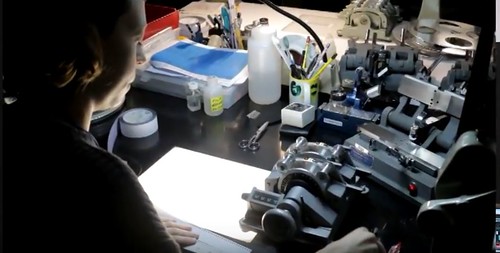
Preservation Technologies successfully developed the patented Bookkeeper® process, which extends the life of books and manuscripts by neutralizing the harmful acids found in paper. PTLP was officially established in 1992 as a limited partnership. Reflecting on successful operations for eight years, Library of Congress requested a partnership with PTLP to set up a facility specifically to treat manuscripts and records in the Madison Building.
Bookkeeper® is the only deacidification method to meet the standards of the Library of Congress as well as current and projected OSHA, FTC and EPA consumer and environmental requirements. Over 550,000 assets from library and archival collections are sent to Preservation Technologies global facilities each year to be deacidified.
Having developed a reputation as a worldwide leader in paper preservation, Preservation Technologies was in a unique position to expand its services to help clients preserve other cultural collections. Large research libraries including NYU, Library of Congress and members of the Committee for Institutional Cooperation would often comment on the need to reformat and preserve their important audio, video and film collections. The MediaPreserve was founded in 2006 as a response to this need.
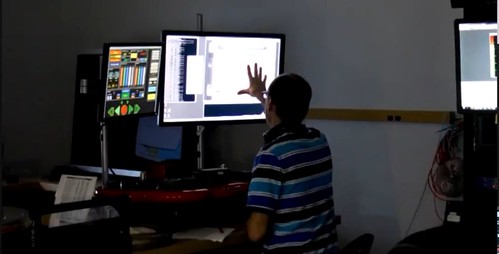
To read the complete article, see:
Preservation Technologies About Us (https://ptlp.com/en/ptlp/overview/about-us/)
WAYBACK MACHINE: THE INTERNET’S TIME CAPSULE
While Internet Archive also does digitization, they came into existence for their primary role of archiving for the long term the ephemeral contents of web pages. Here's a great article from The Hustle on their Wayback machine. See the complete article online - here's a short excerpt. -Editor
 At 300 Funston Street in San
Francisco’s Richmond District, there’s an old Christian Science church. Walk up it’s palatial steps, past Corinthian columns and urns, into the bowels of a
vaulted sanctuary — and you’ll find a copy of the internet.
At 300 Funston Street in San
Francisco’s Richmond District, there’s an old Christian Science church. Walk up it’s palatial steps, past Corinthian columns and urns, into the bowels of a
vaulted sanctuary — and you’ll find a copy of the internet.
In a backroom where pastors once congregated stand rows of computer servers, flickering en masse with blue light, humming the hymnal of technological grace.
This is the home of the Internet Archive, a non-profit that has, for 22 years, been preserving our online history: Billions of web pages, tweets, news articles, videos, and memes.
It is not a task for the weary. The internet is an enormous, ethereal place in a constant state of rot. It houses 1.8B web pages (644m of which are active), and doubles in size every 2-5 years — yet the average web page lasts just 100 days, and most articles are forgotten 5 minutes after publication.
Without backup, these items are lost to time. But archiving it all comes with sizeable responsibilities: What do you choose to preserve? How do you preserve it? And ultimately, why does it all matter?
Today, the Wayback Machine houses some 388B web pages, and its parent, the Internet Archive, is the world’s largest library.
The Internet Archive’s collection, which spans not just the web, but books, audio 78rpm records, videos, images, and software, amounts to more than 40 petabytes, or 40 million gigabytes, of data. The Wayback Machine makes up about 63% of that.
By comparison, the US Library of Congress contains roughly i>28 terabytes of text — less than 0.1% of the Internet Archive’s storage.
I visited the Internet Archive headquarters in San Francisco early in my association with the Newman Portal. The staff is quite dedicated to their mission, and they do a great job. -Editor
To read the complete article, see:
Inside Wayback Machine, the internet’s time capsul
(https://thehustle.co/inside-wayback-machine-internet-archive)
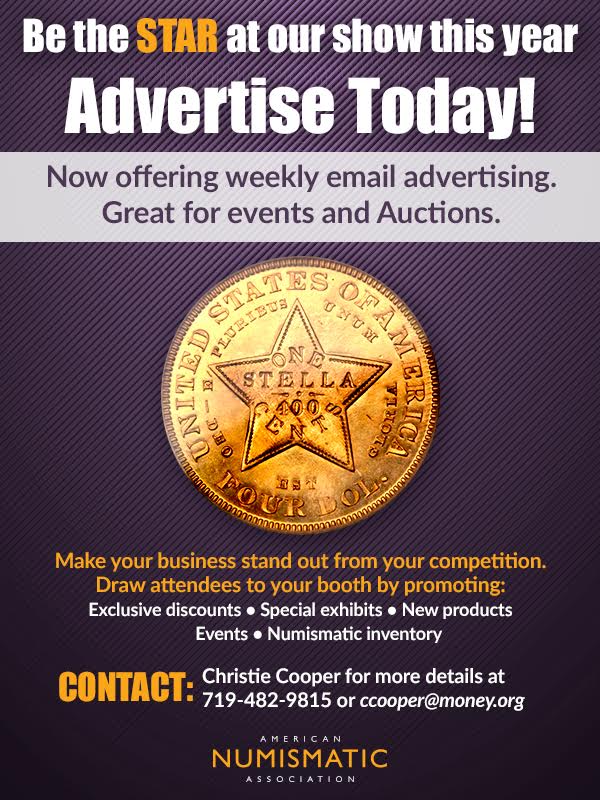
MEXICO'S LIBERTAD COIN DESIGNS
Lou Golino published an Mexico's Libertad coin designs October 30, 2018 in CoinWeek. Here's a short excerpt - be sure to read the complete article online. -Editor
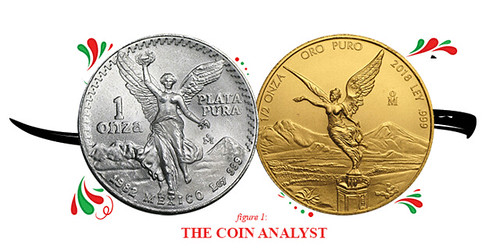
Almost 40 years after the introduction of Mexico’s Libertad — originally intended as a bullion coin that with time became a widely-collected numismatic collectible — the coin remains a perennial favorite in large part because of its stunning design. This design is still seen by collectors today as one of the most beautiful ever to appear on a modern coin and as one with great historic and cultural symbolism.
But unlike other modern coins that sport allegorical symbols of liberty such the American Silver Eagle, whose reverse design is viewed by many collectors as in need of an update, or the Royal Mint and Paris Mint’s issues featuring respectively many different renditions of Britannia and Marianne, there is no discernable interest in changing the Libertad design – either within the Mexican government or among collectors. The coin has, however, seen some modifications to both sides over the years.
The design’s widespread appeal comes not only from its beauty but also its iconic Mexican image, depicting on its reverse side the famous Winged Victory statue, also known as The Angel of Independence, that sits at the top of the monument to Mexican independence in Mexico City. This powerful motif is shown against a landscape with the volcanoes Popocatépetl and Iztaccíhuatl in the background.
To read the complete article, see:
The Coin Analyst: Why the Libertad Design Is Not Likely to Change
(https://coinweek.com/world-coins/the-coin-analyst-why-the-libertad-design-is-not-likely-to-change/)
AUTHOR ROALD DAHL PASSED OVER FOR COIN DESIGN
David Pickup forwarded this The Guardian article about some coins that were NOT made. -Editor
Plans to celebrate the life of Roald Dahl with a commemorative coin were rejected because of concerns about the author’s antisemitic views, it can be revealed.
Official papers obtained by the Guardian using freedom of information laws also disclose that the Royal Mint dropped proposals to issue a coin to mark the centenary of Dahl’s birth because he was “not regarded as an author of the highest reputation”.
The decision is set out in the minutes of a Royal Mint sub-committee meeting held in 2014, where the company instead opted for coins commemorating William Shakespeare and Beatrix Potter.
The decision was made despite the Royal Mail honouring the children’s author with a set of commemorative stamps celebrating his books, many of which have been adapted into films. These include Matilda, Charlie and the Chocolate Factory and the BFG.
A Royal Mint spokeswoman said: “Themes submitted for consideration to feature on Royal Mint coins go through a rigorous planning and design selection process governed by an independent panel known as The Royal Mint Advisory Committee (RMAC).
“Members of this committee include independent experts in the fields of art, history and design, as well as technical specialists from The Royal Mint.
To read the complete article, see:
Anti-Semitic Roald Dahl kept off UK commemorative coins
(https://www.timesofisrael.com/anti-semitic-roald-dahl-kept-off-uk-commemorative-coins/)
ELECTROTYPE MEDAL SHELLS IN ADVERTISING SIGNS
Jeff Rock writes:
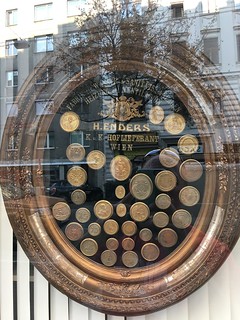 I was out of the country for
a month, and am slowly going through my E-Sylums. In the October 7 issue I noticed the photo of the "medals" for the chocolates. Not sure if others have commented
on this, but the frame likely doesn't contain actual medals, but one-sided electrotype shells attached to a board and then framed -- a neat advertising piece, but not one that
would be worth someone breaking a window and stealing for the medals!
I was out of the country for
a month, and am slowly going through my E-Sylums. In the October 7 issue I noticed the photo of the "medals" for the chocolates. Not sure if others have commented
on this, but the frame likely doesn't contain actual medals, but one-sided electrotype shells attached to a board and then framed -- a neat advertising piece, but not one that
would be worth someone breaking a window and stealing for the medals!
My trip ended in Austria and I saw a similar one on display in a window - where it likely has been for the last century or more! Sorry about the reflection...
That makes sense - a shield made of real medals would also be quite heavy. They look great, and it would be hard to tell at a glance that they're not real medals. -Editor
Harry Waterson writes:
I saw the Chocolate sign on eBay and found it a very interesting piece. I did not buy it so I never got the opportunity to examine it closely. The medallic items could certainly be copies. It was priced as if the medals were struck originals but Jeff Rock makes a valid observation. I’d be interested to know Rich Jewell’s assessment of the authenticity of the medals in the sign that he has in his collection.
Since you have pictures of all three pieces, can you determine if they were all made by the same company? There is a small maker’s plate at the bottom of each frame.

Chocolate Medal Sign Maker

Maker H. Enders medal sign
I could not see a maker name or tag on the "Le Médaillier" sign, and the one on the Austrian "H. Enders" sign is unreadable in the photo. But the Chocolate Medal sign maker appears to be somewhat readable. To me it looks like "A Mabonnet," but even that's a guess.
Harry and I next reached out to Richard Jewell, who owns the "Le Médaillier" sign. -Editor
Rich Jewell writes:
I would concur with Jeff Rock's assessment! They are not medals but one sided electrotype shells locked onto a board. Someone had torn off a little piece of the backing on my sign and a lug nut can be seen holding the piece in place. Another point to add, the sign does not support the theory of actual medals since the weight of the sign is totally too light for all the medals and decorations present. There is no name plate or tag at the bottom of "Le Medaillier"-it still is an awesome advertising piece!
Thanks, everyone. -Editor
To read the earlier E-Sylum articles, see:
19TH CENTURY EXPOSITION MEDAL COLLECTION (http://www.coinbooks.org/v21/esylum_v21n40a26.html)
LE MéDAILLIER MEDAL SHIELD (http://www.coinbooks.org/v21/esylum_v21n42a22.html)
MORE HYDRA IMAGES IN NUMISMATICS
Last week we discussed coin or medal designs featuring the mythical multi-headed creature the hydra. William Todd submitted three additional images. Thanks! -Editor



1. Anita Lehzen (medallist). Das Grosse Dreschen (the great thrashing). 1914. From early on, Germany portrayed itself as set upon by a multi-headed enemy, here symbolized by a hydra with animal heads representing the members of the Entente: behind the knight, the injured Russian Bear seems to be collapsing, while in front the Gallic Cock and the English Bulldog(?) threaten.
2. Louis Heitsch. Viel Feind - viel Ehr (many enemies - much honor). 1915
3. Carl Stock. Hilfe für Kriegsgefangene deutsche (assistance for German war prisoners). 1915. Not technically a warrior fighting a hydra, but nevertheless...
William adds:
In addition, below are some medals in this category that are presently available from dealers in Germany.
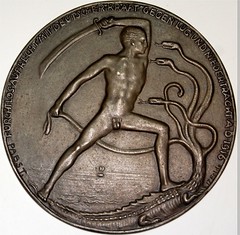
One-sided cast iron medal 1916, by Pabst. Unclothed youth with sword fighting a sea monster symbolizing the enemies of Germany, sea in background with ship. 144.0 mm. This is possibly a prototype for a medal never produced and may thus be the only example in existence.
To read the complete item description, see:
Medal 1916 World War One General propaganda Unique? Gussfrisch
(https://www.ma-shops.de/hossfeld/item.php?id=171103001)
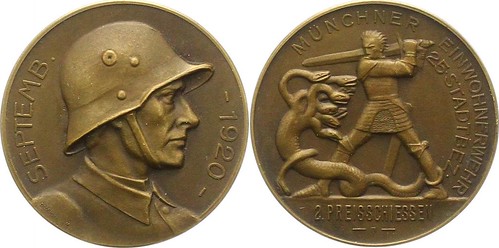
To read the complete item description, see:
Bronze medal 1920 Bayern Munich, city Excellent +
(https://www.ma-shops.de/loebbers/item.php?id=180129002&lang=de)
To read the complete article, see:
HYDRA IMAGES IN NUMISMATICS (http://www.coinbooks.org/v21/esylum_v21n44a14.html)
CHRISTIE'S SELLS STEPHEN HAWKING'S MEDALS
I'll give the Great Headline award to Art Daily for "Hawking auction raises astronomical sum." -Editor
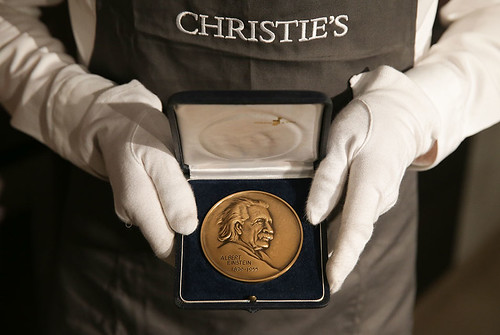
A copy of Stephen Hawking's doctorate thesis signed in a shaky hand was the highlight of an auction of the British physicist's personal items in London, which raised nearly £1.4 million ($1.8 million, 1.6 million euros).
The copy, one of only five originals of the thesis entitled "Properties of expanding universes", smashed pre-sale expectations four times over to sell for £584,750 at the Christie's sale, which ended on Thursday.
A red leather wheelchair that Hawking used from the late 1980s to the mid-1990s, driving himself using a joystick, sold for £296,750 while an early edition of his bestselling book "A Brief History of Time" marked with a thumbprint, fetched £68,750.
A script from one of his appearances on the television series "The Simpsons" was one of the 22 lots under the hammer, selling for £6,250.
A collection of his medals and awards, including honours from the Royal Astronomical Society, sold for £296,750, with the entire collection achieving £1,384,625.
To read the complete article, see:
Hawking auction raises astronomical sum
(http://artdaily.com/news/109022/Hawking-auction-raises-astronomical-sum#.W-bTVJNKiAs)
HOW THE CURRIE VICTORIA CROSS STAYED IN CANADA
Remember that Victoria Cross medal that Canadians fought to keep in their country? Here's an article with background on how the successful effort came together. -Editor
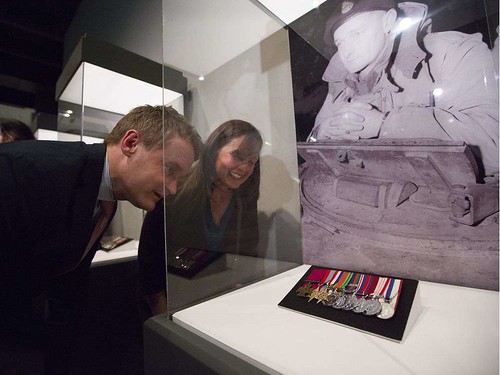
Veterans Affairs Minister Seamus O’Regan and Lt.-Col. David Currie’s granddaughter Sandy Currie observe his Victoria Cross medal set in Ottawa.
The story of Currie’s Victoria Cross and his other medals — how they were sold by his widow, and subsequently purchased by the unidentified foreign collector for $660,000 — has been widely reported.
Hidden in that story, however, is the fact that Stromberg, Brownlee and two other local families — Sandra and Dallas Howe and Heather Ryan and L. David Dubé — put up what the lawyer said was “more than half” of the Canadian bid.
Stromberg said he was inspired to help fund the bid because the Saskatchewan-born soldier’s medal is an “important Canadian cultural artifact” that should have stayed in Canada, and not been shipped off to a collection in another country.
Jeff Noakes, a Second World War historian at the Canadian War Museum in Ottawa, said the collective effort to keep Currie’s decorations in Canada underscores just how important he and the Battle of Normandy are.
“These are all people, and these are their stories — and these awards help tell those stories, and through them the experiences of Canadians and of Canada, and its military history,” Noakes said.
Stromberg said that while only three of the people he approached to fund the Canadian War Museum’s bid — which also included government support — agreed to help, he has no regrets — and can’t wait to see the medal for himself.
“We did feel pretty darn good about it.”
The medal was on public display until May. The Canadian War Museum is looking at ways to put it on permanent display.
Congratulations to all involved for a job well done. What a great way to honor a local hero. -Editor
To read the complete article, see:
Saskatchewan families helped keep Currie Victoria Cross in
Canada (https://thestarphoenix.com/news/local-news/saskatchewan-families-helped-keep-currie-victoria-cross-in-canada)
To read the earlier E-Sylum articles, see:
CURRIE CANADIAN VICTORIA CROSS TO BE SOLD (http://www.coinbooks.org/v20/esylum_v20n35a26.html)
CURRIE CANADIAN VICTORIA CROSS SOLD (http://www.coinbooks.org/v20/esylum_v20n40a32.html)
CURRIE CANADIAN VICTORIA CROSS SALE REVIEW (http://www.coinbooks.org/v20/esylum_v20n49a34.html)
CURRIE VICTORIA CROSS TO STAY IN CANADA (http://www.coinbooks.org/v21/esylum_v21n18a32.html)
PRESIDENT WOODROW WILSON MEDAL PUZZLE ANSWERS
Last week Harry Waterson submitted this puzzle using front-face images of President Woodrow Wilson. -Editor
Match the obverses (A-F) with the correct reverses (1-6)

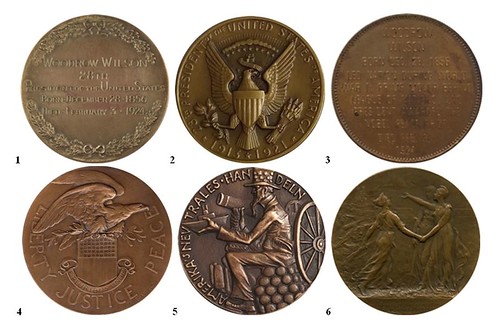
Pete Smith submitted these answers:
A-5 Karl Goetz Satirical Medal
B-6 1917 by Rene Gregoire
C-2 Medalic Art Company; A slight variant was done by Whitman Publishing
D-4 Liberty / Justice / Peace by Jules-Prosper-Joseph-Marie-Edmond-Legastelois
E-1 1924 Memorial Medal - Robbins Co.
F-3 Franklin Mint
Harry Waterson writes:
Here are the correct matches.
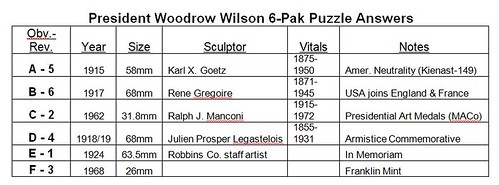
Great puzzle, Harry. Pete Smith's answers were right on the money! Thanks, everyone. -Editor
PANCHO VILLA'S PAPER MONEY
DelanceyPlace.com publishes interesting book excerpts daily. The November 6, 2018 article discusses the paper money of Mexican revolutionary Pancho Villa. -Editor
Today's selection -- from Villa and Zapata: A History of the Mexican Revolution by Frank McLynn.
 The revolutionary Pancho Villa
funded his military exploits by stealing or appropriating goods among the wealthy, in part from taxes, and in part by printing his own currency and paying for goods with this
currency. For an extended time, this new currency actually worked, in large part because he forced it to work at gunpoint:
The revolutionary Pancho Villa
funded his military exploits by stealing or appropriating goods among the wealthy, in part from taxes, and in part by printing his own currency and paying for goods with this
currency. For an extended time, this new currency actually worked, in large part because he forced it to work at gunpoint:
"[An] aspect of Villa's economic overlordship deserve[s] special attention: his attitude to the money supply. ... An economic simpleton, Villa saw no reason why he could not simply print the money he needed, and to an extent the American banks in El Paso colluded with this by accepting his currency at eighteen-nineteen cents on the dollar, on Villa's guarantee. Villa's assault on market orthodoxy was more difficult to handle, especially when he gave the poor of Chihuahua fifteen dollars each on Christmas Day 1913, and then fixed the price of staples: beef was to be sold at seven cents a pound, milk at five cents a quart and bread at four cents a loaf.
"Mexican merchants tried to evade Villa's price fixing by pricing their goods on a two-tier system, one price quoted against Mexican silver money, the other against Villa's paper money. Villa retaliated by ordering a mandatory sixty days in jail for anyone caught discriminating against his currency. When that measure failed to work, and people continued to hoard silver and 'real' bank bills, Villa declared that all such money not exchanged for his currency at par within a week would cease to be legal tender and its holders treated as counterfeiters. This tough measure panicked the hoarders into disgorging."
To read the complete article, see:
Today's selection -- from Villa and Zapata: A History of the
Mexican Revolution by Frank McLynn. (https://mailchi.mp/delanceyplace.com/concentration-camps-in-mexico-90418-zi3j99py8x-1145901?e=6d5f847753)
WHAT IS A "SHORT SNORTER?"
Jeffrey Wing's PaperMoneyMessages site has a nice overview of short snorters. -Editor
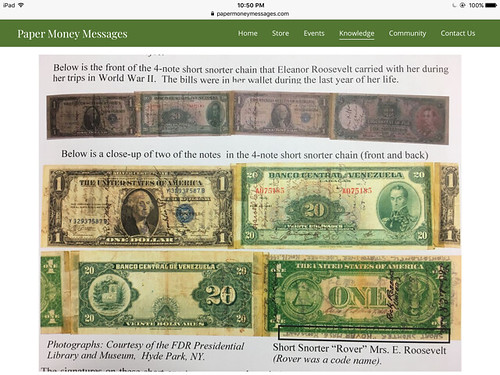
A “short snorter” is a banknote signed by various persons meeting together or made to commemorate a special event (solo flight, trans-oceanic flight, trip crossing equator or international dateline, etc.). The tradition started sometime shortly after WW I and spread with the barnstormers, bush pilots in Alaska in the 1920’s, and balloonists. The Pan American Airlines “Clippers” which flew from the mainland of the US to Hawaii, South America, and points beyond hastened the spread of the tradition which then grew exponentially during World War II.
A short snorter can also be a long chain of snorter notes connected by tape or staples (above image). Sometimes multiple notes from various countries would be taped together so that the holder of the notes had a record of where they have been and who they met. A “Short Snorter” is an individual who has become a member of the short snorter tradition. If you signed a short snorter and that person could not produce it later upon request, they owed you a dollar or a drink, a “short snort” (because aviation and alcohol do not mix!), thus the name “Short Snorter”. It was common for very important people (VIPs) to autograph short snorters during USO trips in WW II.
To read the complete article, see:
What is a "short snorter?"
(https://papermoneymessages.com/knowledge#cb6368a8-73ba-42f5-a1fd-11818d0c58ca)
LOOSE CHANGE: NOVEMBER 11, 2018
Here are some additional items I came across in the media this week that may be of interest. -Editor
The Confederate Half Dollar
Dave Bowers published a nice article on the Confederate Half Dollar on the Mint News Blog November 7, 2018. -Editor
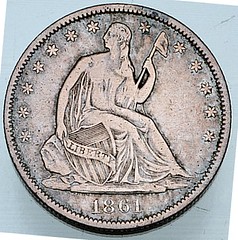

After seven states seceded from the Union, beginning with South Carolina in December 1860, the Confederate States of America was formed with its capital as Montgomery, Alabama. The federal branch mint in New Orleans fell in the hands of the seceded State of Louisiana and the Confederacy. Starting in January 1861, about 5,000 double eagles are said to have been struck at New Orleans along with about 330,000 silver half dollars, both from regular federal dies on hand. At a distance, the Dahlonega Mint in Georgia struck gold dollars from regular dies.
Unknown to historians and others was the Confederacy’s effort at creating its own distinctive coinage. This changed in June 1879, when Ebenezer Locke Mason, Jr., in Mason’s Coin Collectors’ Herald Vol. I, published an article, “History of the recently discovered CONFEDERATE SILVER HALF DOLLAR., Struck by C.S.A., at New Orleans Mint. April, 1861,”
To read the complete article, see:
Bowers on collecting: The 1861 Confederate half dollar
(http://mintnewsblog.com/bowers-on-collecting-the-1861-confederate-half-dollar/)
Germany's Ghost Money
Numismatourist Howard Berlin (who's actually in Berlin tonight) passed along this article he saw on the Deutsche Welle news site. It's about the large number of German marks still in circulation. -Editor
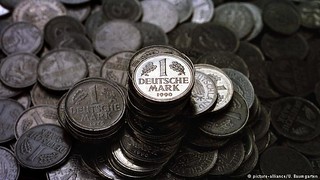 Nostalgia can be a powerful temptation.
But the dozens who line up each morning at Germany's central bank, the Bundesbank, are perhaps among the less sentimental. A smorgasbord of the elderly, young mothers with
children in tow and students, they have one thing in common and more often than not it's hidden inside a heavy bag.
Nostalgia can be a powerful temptation.
But the dozens who line up each morning at Germany's central bank, the Bundesbank, are perhaps among the less sentimental. A smorgasbord of the elderly, young mothers with
children in tow and students, they have one thing in common and more often than not it's hidden inside a heavy bag.
Nearly 28 years after the complete demise of the East German mark and 16 years after the introduction of the euro, these people are patiently waiting to hand in some of the billions of old deutschmarks still in circulation.
These marks are not worthless and — if issued after June 20, 1948 — can be exchanged in unlimited amounts for euros at one of the 35 branch offices of the Bundesbank indefinitely. And unlike most currencies, the official exchange rate of 1 euro for 1.95583 marks has remained unchanged since it was established in 2001.
To read the complete article, see:
The never-ending story of Germany's ghost money
(https://www.dw.com/en/the-never-ending-story-of-germanys-ghost-money/a-4398017)
$20 Delhi, Louisiana National Bank Note Found
A Numismatic News article by Peter Huntoon highlights a newly discovered rarity in the field of U.S. National Bank Notes - a a 14000-charter number from a previously unreported bank. -Editor
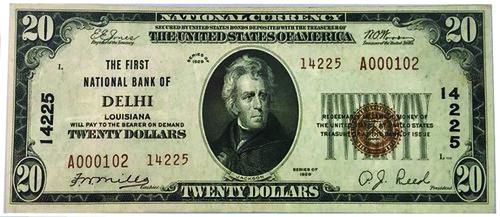
To read the complete article, see:
Newly discovered note with 14000-charter number
(http://www.numismaticnews.net/article/newly-discovered-note-with-14000-charter-number)
The "Voter Fraud" is a Fraud Stamp
The November 6, 2018 issue of News & Notes from the Society of Paper Money Collectors included a link to an article promoting a stamp promoting new voter rights laws. -Editor

To read the complete article, see:
Stop the Attack on Voting Rights
(https://www.stampstampede.org/money-out-voters-in/stop-attack-on-voting-rights/)
Northern Ireland Banks Switching to Polymer
Two banks in Northern Ireland are introducing polymer banknotes. Here's an excerpt from a BBC News article. -Editor
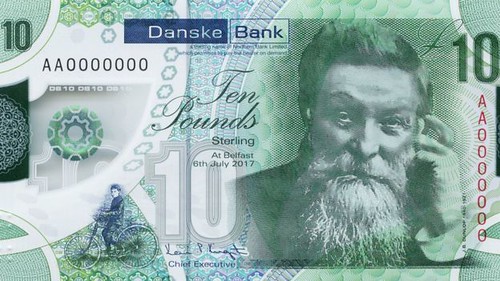
Two Northern Ireland banks have announced a switch to polymer £5 and £10 notes.
The new Danske Bank and Bank of Ireland currency will enter circulation in February 2019.
Northern Ireland's four banks can print their own money and three of them are now all set for change.
To read the complete article, see:
Danske and Bank of Ireland to introduce 'plastic notes'
(https://www.bbc.com/news/uk-northern-ireland-46099493)

